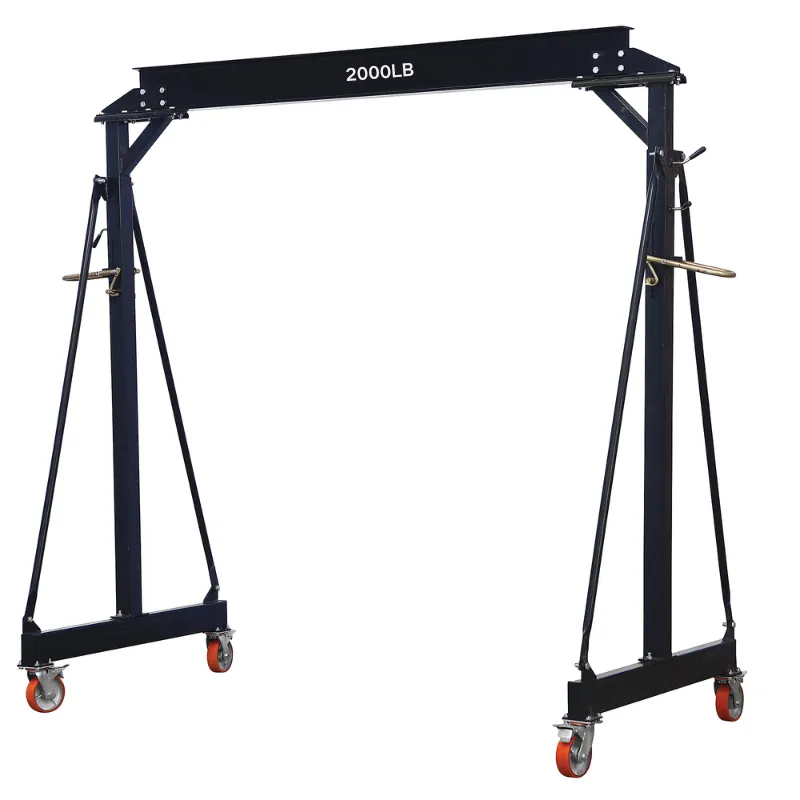gantry crane small
Understanding the Importance and Functionality of Small Gantry Cranes
In the field of material handling and construction, gantry cranes play an essential role by enhancing efficiency and ensuring safety during the lifting and moving of heavy loads. Among the various types of gantry cranes available, small gantry cranes have gained significant traction, particularly in small workshops, warehouses, and construction sites. This article delves into the importance, functionality, and advantages of small gantry cranes, highlighting why they are becoming increasingly popular in various industries.
What is a Small Gantry Crane?
A small gantry crane is a type of overhead lifting equipment that features a framework supported by legs on either side of a runway beam. Unlike large gantry cranes used in shipyards or large construction sites, small gantry cranes are designed for tasks that involve lighter loads and smaller spaces. Typically capable of lifting weights ranging from a few hundred pounds to a few tons, these cranes are often constructed from materials such as aluminum or steel, ensuring both durability and lightweight convenience.
Key Features and Components
Small gantry cranes are equipped with several vital components that support their functionality
1. Support Structure The framework is typically composed of two vertical masts connected by a horizontal beam. This design allows for stability and strength while lifting items. 2. Wheels Many small gantry cranes come with wheels, allowing for easy mobility within a workspace. Users can relocate the crane as needed, making it adaptable to various applications. 3. Hoisting Mechanism At the top of the crane, a hoist is present to lift and lower materials. The hoist can be manual or electric, depending on the model and the weight capacity required. 4. Adjustable Height Some small gantry cranes are designed to allow height adjustment, making them versatile for various lifting tasks.
Applications of Small Gantry Cranes
Small gantry cranes can be found in diverse settings due to their flexibility. Common applications include
gantry crane small

- Manufacturing In factories, small gantry cranes are used to move components and equipment during assembly processes. Their ability to lift heavy parts with precision helps streamline production lines. - Maintenance and Repair Workshops often rely on small gantry cranes for lifting engines, machinery parts, and other heavy equipment for maintenance work. They provide the necessary strength while taking up minimal space. - Construction Sites Small gantry cranes are frequently employed for lifting materials like bricks, steel beams, and tools, especially in confined areas where larger equipment cannot operate efficiently.
Advantages of Small Gantry Cranes
The increasing utilization of small gantry cranes can be attributed to several advantages
1. Space Efficiency Small gantry cranes are ideal for limited spaces. Their compact design allows them to fit into tight work areas where traditional cranes cannot operate. 2. Cost-Effectiveness Compared to larger cranes, small gantry cranes are generally more affordable both in terms of initial purchase and maintenance costs. This affordability makes them an attractive option for small businesses and startups.
3. Ease of Use Operating a small gantry crane is relatively simple, which minimizes the need for extensive training. Many models are portable, allowing easy relocation to different job sites.
4. Safety These cranes are designed with safety features to ensure secure lifting and lowering of heavy loads. They minimize physical strain on workers, reducing the risk of injuries associated with manual lifting.
Conclusion
As industries continue to evolve, the demand for efficient, compact, and economical material handling solutions remains high. Small gantry cranes stand out as versatile tools that cater to the needs of various sectors, enhancing productivity while ensuring safety and ease of use. By understanding their features, applications, and advantages, businesses can make informed decisions on integrating small gantry cranes into their operations, ultimately optimizing workflows and improving overall efficiency. As technology advances, we can expect these cranes to become even more sophisticated, continuing to play a vital role in modern material handling practices.
-
Unlock Seamless Relocation with Our Heavy Equipment Moving ExpertiseNewsJun.06,2025
-
Unleash Unrivaled Flexibility with Our Adjustable Gantry CraneNewsJun.06,2025
-
Unleash Heavy-Duty Efficiency with Our Industrial Gantry Crane SolutionsNewsJun.06,2025
-
Revolutionize Steel Handling with Our Magnetic Lifter RangeNewsJun.06,2025
-
Master Equipment Mobility with Premium Machinery Mover SolutionsNewsJun.06,2025
-
Elevate Your Material Handling with Magnetic Lifter TechnologyNewsJun.06,2025
-
YS Permanent Lifting Magnets: The Smarter Way to Handle SteelNewsMay.22,2025
